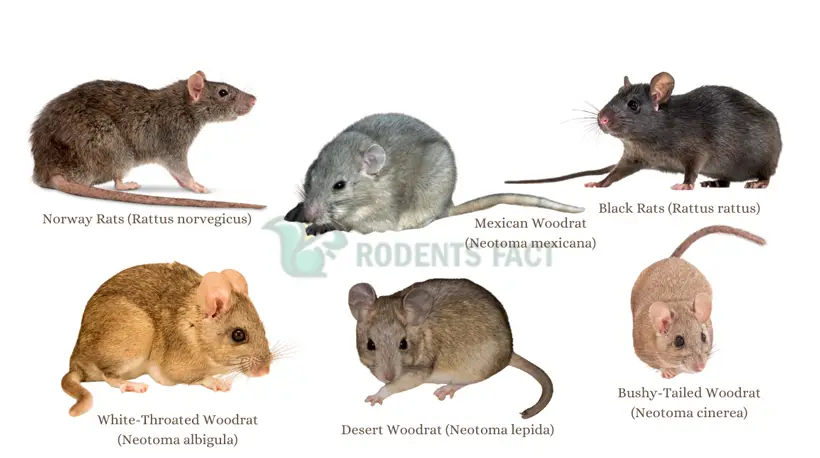6 Types of Rats in Utah: Features, Habitat, and More!
Thanks to the diversity of habitats and plenty of food sources, Utah has become a safe haven for rats. When you encounter one of these little creatures, you might get curious about their identity, origin, habits, and behavior.
There are many different types of rats in Utah. There are Norway or brown rats and black rats that live around the common households of Utah. Utah has other rat species, like the white-throated woodrats and bushy-tailed woodrats, that are widely considered pests as they destroy crops. You can also find desert woodrats and Mexican woodrats in the rocky areas of Utah.
Read on to discover the various rat types you can find in Utah and some of their features and behaviors.
Identifying 6 Different Types of Rats You Can Find in Utah

Before we dive into the details, let’s take a quick look at the origin, habitat, and appearance of the most common rats in Utah.
| Rat Species | Origin | Habitat | Length | Weight | Color |
|---|---|---|---|---|---|
| Norway Rat (Rattus norvegicus) | Asia | Forests, sewers, basements, and open fields | 7 to 9.5 inches | 200 to 500 grams | Coarse brown fur with a gray, black, or yellow underbelly |
| Black Rat (Rattus rattus) | Asia | Trees, rocks, forests, cliffs, on the ground | 5 to 7.2 inches | 110 to 340 grams | Black or brown with lighter black or gray underbelly |
| Bushy-Tailed WoodRat (Neotoma cinerea) | Unknown | Deserts, forests, cliffs, rocky outcroppings | 13 to 17 inches | 300 to 600 grams | Brown or grayish fur with white underbelly |
| White-Throated Woodrat (Neotoma albigula) | Arizona | Grassland, deserts, empty buildings | 12.9 inches on average | 188 to 224 grams on average | Gray or tawny with white underbelly |
| Desert Woodrat (Neotoma lepida) | North America | High desert regions, rocky areas, forests, and human-made structures | 9 to 15 inches | 122 to 350 grams | Grey body fur with light gray to yellow underbelly |
| Mexican Woodrat (Neotoma mexicana) | Mexico and southern parts of the United States | Crevices, cracks, and caves in high altitudes | 11.8 inches | 140 to 185 grams | Greyish-brown upper coat with white underbelly |
Norway Rats (Rattus norvegicus)
Also known as the brown rat, sewer rat, and street rat, Norway rats are probably the most common species in Utah. Although they have ‘Norway’ in the name, the Norway rats actually originated in Asia. Yet, the species is now widespread in the North American states, including Utah.

- Appearance: As the name suggests, Norway or brown rats feature coarse brown fur with a gray, black, or yellow underbelly. The rodent is about 7 to 9.5 inches long with a heavily built body. Adult Norway rats weigh about 200 to 500 grams.
- Habitat: Being commensal rodents, Norway rats inhabit wherever humans live. However, these rodents are a common sighting in forests, sewers, basements, and open fields where plenty of food sources are available.
- Behavior: While wild Norway rats are more aggressive and involved in chasing and fighting, domestic rats are shy and timid. In fact, you can keep domesticated brown rats as pets.
As these rodents are nocturnal, they are typically active during dusk. Although they have poor vision, Norway rats have excellent hearing and smell senses.
- Health Risks: Brown rats possess serious health risks as their urine and saliva can contaminate food items. They are the known carriers of diseases and parasites like typhus, Weil’s disease, mites, ticks, and trichinosis.
Black Rats (Rattus rattus)
Similar to brown rats, black rats are also native to Asia. The species is abundant in Utah, and you can easily identify them for their appearance.
- Appearance: While the outer coat of black rats is typically black or brown, the underside of their body is typically lighter black or gray. The rodent is 5 to 7.2 inches long and weighs approximately 110 to 340 grams. It has a thin tail that’s longer than its body.
- Habitat: Wild black rats live in trees, rocks, forests, riverbanks, cliffs, or on the ground. However, the species can adapt to various types of climates and habitats.

In urban areas, you can find them near crop fields, residential buildings, and false ceilings. Hence, they got the name ‘roof rats’.
- Behavior: In general, black rats are nocturnal and prefer to go out after sunset. Being highly social animals, they live and look for food in groups.
Black rats are aggressive and noisy while communicating with other rats. They have well-developed senses of vision and hearing.
- Health Risks: As black rats carry several ectoparasites and zoonotic pathogens, they can cause many nasty diseases. Some of these include typhus, trichinosis, and plague.
Bushy-Tailed Woodrat (Neotoma cinerea)
While the above-mentioned rat species are aggressive and noisy, the bushy-tailed woodrats are shy and difficult to find. The species is found in North America, Canada, and Mexico.
- Appearance: One key identifying feature of this species is its bushy tail that’s up to 7.5 inches long. An adult bushy-tailed woodrat is about 13 to 17 inches long and has a body weight of 300 to 600 grams. The rodent has brown or grayish fur and a white underbelly.
- Habitat: Due to their ability to adapt to various climates, bushy-tailed woodrats are found everywhere, from deserts to forests. This woodrat species usually lives in isolated high areas such as cliffs, rocky outcroppings, caves, and abandoned buildings.
- Behavior: The bushy-tailed woodrat leads a sedentary lifestyle and spends its day looking for food. Apart from food items, they also collect other interesting things such as bones, paper, sticks, etc. Hence, the woodrats are also known as ‘pack rats.’
- Health Risks: They are well-known hosts of plague. Also, if an infected rat scratches or bites you, it can result in rat-bite fever.
White-Throated Woodrat (Neotoma albigula)
One of the most recognizable rat species found in Utah, the white-throated woodrat is widespread all over the United States and Central Mexico. The species is identified by its bi-colored tail and white patches on the throat.
- Appearance: While the body fur of the white-throated woodrat is typically gray or tawny, its underside is white. Instead of a hairless tail, the rodent features a furry tail that’s grayish brown on top and white on the bottom.

White-throated woodrats are 12.9 inches long and weigh from 188 to 224 grams on average.
- Habitat: Although white-throated woodrats prefer to live in grasslands, they can also thrive in deserts. They habitat on bushes and succulents for better cover and food. In the urban areas, these rodents live in burrows near crop fields and human-made structures.
- Behavior: White-throated woodrats are adapted to a solitary lifestyle. They are shy and prefer to live in their burrows or caves.
This species is particularly known for their middens, which they construct with various plant materials. One unique trait of white-throated woodrats is that these rodents like shiny objects like CDs or metal keys.
- Health Risks: As they carry various pathogens, white-throated woodrats can infect humans by food contamination. Recent findings suggest that white-throated woodrats can transmit arenavirus.
Desert Woodrat (Neotoma lepida)

Originated from North American deserts, the desert Woodrat is found in southeastern Oregon, Idaho, California, and Mexico, along with Utah. You can easily recognize the rat from its narrow snout, long ears, and bi-colored body.
- Appearance: With their light or dark gray body fur and light gray to yellow underside, desert woodrats are identified by their distinctly bi-colored body. The rodent is 9 to 15 inches long and weighs about 122 to 350 grams.
- Habitat: As the name implies, desert woodrats are found in high desert regions. These rodents typically choose desert succulents to dwell in as they provide both shelter and food. Apart from deserts, they also have habitats in rocky areas, forests, and human-made structures.
- Behavior: Similar to other woodrats, the desert woodrat is also known as a ‘pack rat.’ They collect any small and shiny objects that they find interesting. Desert rats are solitary animals and prefer to live in their caves or nests. These rats are pretty aggressive, especially when raising their young.
- Health Risks: Desert rats can be responsible for transmitting zoonotic diseases and infections through viruses (such as Hantavirus) and bacteria.
Mexican Woodrat (Neotoma mexicana)

From Utah and Arizona to New Mexico, the Mexican woodrat is another notable species of pack rat. As they don’t particularly like human interactions, it might be a bit difficult to find them in the regular households of Utah.
- Appearance: While this medium-sized woodrat has a grayish-brown upper coat, the underparts are white, which makes them easily distinguishable. Instead of a hairless tail, the rodent has a bushy one with gray fur. Mexican woodrats are up to 11.8 inches long and weigh around 140 to 185 g.
- Habitat: Just like other woodrats, the Mexican woodrat prefers to live in high altitudes. It takes shelter in crevices, cracks, and caves far from the eyes of predators. As for the rural areas of Utah, they live in empty buildings.
- Behavior: Unlike other woodrats, the Mexican woodrat doesn’t make long middens over the ground. They take the plant materials inside their caves and construct smaller middens. Mexican woodrats are also aggressive while defending their territories and prefer to live alone.
- Health Risks: Being a highly plague-susceptible rat, the Mexican woodrat poses serious health risks. According to some sources, the Enzootic plague is most likely to reduce the lifespan and survival chances of this species.
FAQs
Got more questions about rats in Utah? Here are some common queries answered to provide you with a deeper insight into the rodent species of Utah.
Q: Are rats native to Utah?
No, rats aren’t native to Utah. Instead, most rat species in Utah are introduced by humans. The common brown and black rats are native to Asian countries such as China and India.
Q: What are the living conditions for rats in Utah?
The living conditions of Utah are ideal for rats because of its dry and semi-arid climate. It also has deserts, which are perfect for woodrat species. In the urban areas, rats build nests in attics, vacant buildings, and basements where sufficient food sources are available.
Q: How do I get rid of rats in Utah?
To get rid of rats in Utah, first, locate and seal all the holes and cracks that allow rats to get into your house. Remove their food sources, including garbage, pet food, bushes, and weeds located around the buildings. Finally, set traps or contact pest control if the problem persists.
Wrapping Up!
While describing 6 types of rats in Utah, we’ve discussed the most common species, including the Norway rats, black rats, and bushy-tailed woodrats. We have also discovered the appearance, habitat, and behavior of other common rat species in Utah, including white-throated woodrat, Mexican woodrat, and desert woodrat.
While some of these rodents can be kept as pets, most of them are destructive and carriers of harmful diseases. Therefore, it’s best to get rid of them by sealing the entryways of your house or getting help from the pest control units of Utah.




